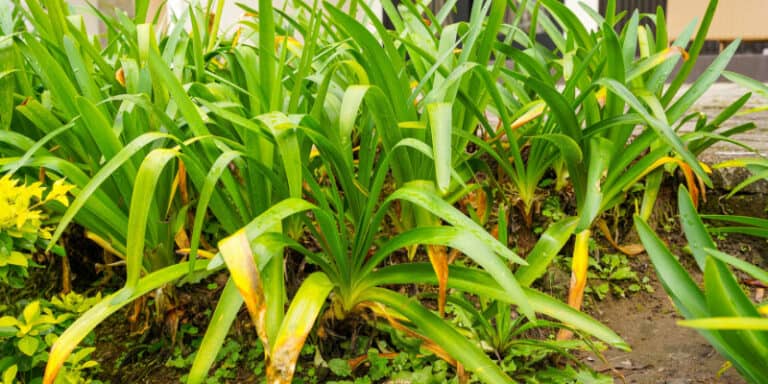When you spot the lush leaves of your agapanthus turning a worrying shade of yellow, it can really throw a spanner in the works for any gardener. This all-too-common issue tends to sneak up on us, sparking a bit of a scramble to find remedies.
But here’s a bit of good news: You’re certainly not battling this alone. Many of us have watched, with a fair bit of disappointment, as our cherished plants started looking less than chipper.
Quite often, it turns out that an iron deficiency is at the heart of this pesky yellowing.
After doing some serious digging and having yarns with several gardening gurus, we’ve managed to put together quite the comprehensive guide for taking this problem head-on. Our advice covers everything from understanding why your agapanthus might be feeling off colour to implementing straightforward solutions—so you can rest easy knowing we’ve got your back.
Agapanthus, also known as African Lily or Lily of the Nile, is a popular ornamental plant grown for its attractive blue or white flowers. However, despite being relatively easy to grow, Agapanthus leaves turning yellow is a common problem that plagues even experienced gardeners.
Yellowing leaves on your prized Agapanthus can be alarming but don’t fret – the causes are usually easily identifiable and treatable if caught early. By understanding the potential reasons behind the yellowing, you can take appropriate corrective actions to restore the health and beauty of your Lilies of the Nile.
What Causes Agapanthus Leaves to Turn Yellow?
There are several possible causes behind yellowing leaves on Agapanthus plants:
Overwatering
Excessive watering is one of the most common reasons for yellowing leaves on Agapanthus. These plants thrive in well-draining soil and can’t tolerate soggy conditions. Overwatering causes root rot which prevents the roots from absorbing nutrients. This leads to nutrient deficiencies in the plant, causing the leaves to turn yellow.
Poor Drainage
Inadequate drainage leads to waterlogged soil which damages the roots and stunts the plant’s growth. If the excess moisture has no escape, it breeds fungi and bacteria that infect the roots. The compromised roots are unable to supply nutrients to the rest of the plant leading to yellowing foliage.
Nutrient Deficiencies
Lack of important nutrients like nitrogen, iron, magnesium, and manganese can cause Agapanthus leaves to turn yellow. Iron deficiency is particularly common in alkaline soils, where iron becomes unavailable for uptake by plants. Without iron, Agapanthus cannot produce chlorophyll, leading to yellowing leaves.
Pests
Sap-sucking pests like aphids, mealybugs, and spider mites can infest Agapanthus plants. They feed on plant juices, causing malformed growth and yellowing leaves over time. A heavy infestation can even kill the plant.
Diseases
Fungal diseases like root rot, leaf spot, botrytis blight, and powdery mildew are common Agapanthus afflictions. They thrive in moist conditions, infecting plants and obstructing their vascular functions. This prevents water and nutrients from reaching the leaves, turning them yellow.
Sun Exposure
Too much harsh sun can scorch and yellow the leaves of Agapanthus plants. Such sunburn damage is common in summers and occurs when the plants receive more than 6 hours of direct sunlight daily.
Transplant Shock
Replanting or dividing Agapanthus can shock them, especially if done during hot weather. Transplant shock interrupts the plant’s vascular functions, preventing proper water and nutrient movement. This stress can cause temporary yellowing of leaves.
Cold Weather
Frost damage and winter dormancy can also cause yellowing leaves in Agapanthus. As the plants enter dormancy in winter, the older foliage starts dying back and turning yellow. Light frost can also dehydrate and yellow the leaves.
How to Fix Yellow Leaves on Agapanthus
Now that you know what causes yellowing leaves in Agapanthus, here are some corrective actions you can take to nurse your plants back to health:
-
Adjust watering habits – Allow the soil to partly dry out between waterings and improve drainage if need be. Water only when the top inch of soil is dry to avoid overwatering.
-
Treat nutrient deficiencies – Get a soil test done to identify lacking nutrients. Apply a balanced liquid fertilizer like a 20-20-20 NPK weekly. Iron supplements help correct iron chlorosis.
-
Control pests – Remove visible pests manually and spray neem oil or insecticidal soap solution on infested plants. Sticky traps help control flying pests like whiteflies.
-
Prevent diseases – Improve air circulation and avoid overcrowding plants. Remove diseased foliage promptly. Apply fungicides at the first sign of infection.
-
Provide shade – Use sheer curtains, shade cloth or position plants where they receive morning sun only.
-
Allow time to recover – Transplant shock and winter leaf yellowing resolve on their own in time. Just ensure proper care meanwhile.
-
Monitor regularly – Routinely inspect plants for pests, diseases and other issues. Timely care prevents major leaf damage.
With some attentive care and plant husbandry, your Agapanthus will soon regain its glossy green foliage and dazzling blooms. Be patient and persistent in nursing the plant back to vigor.
Preventing Leaf Yellowing in Agapanthus
Prevention is always better than cure when growing plants. Here are some tips to avoid leaf yellowing issues in Agapanthus:
-
Choose disease-resistant cultivars like ‘Blue Heaven’ and ‘Storm Cloud’.
-
Plant in well-draining soil enriched with compost. Improve drainage if need be.
-
Water deeply but infrequently. Allow soil to partly dry out between waterings.
-
Feed with balanced fertilizer every 4-6 weeks during spring and summer.
-
Provide partial shade if planting in hot regions. Protect from frost in winters.
-
Prune spent blooms and Mulch to conserve moisture and suppress weeds.
-
Monitor regularly for pests and promptly address issues before they escalate.
-
Avoid transplanting or dividing plants during hot, dry weather.
-
Maintain proper spacing between plants to allow air circulation.
Final Thoughts
While yellow leaves on your prized Agapanthus plants can be worrying, the causes are usually easily remedied with some attentive plant care. Stick to these best practices in watering, fertilization, pest management and general maintenance to avoid leaf yellowing issues.
But if your Lilies of the Nile do start showing signs of yellow foliage, diagnose the cause early and take prompt corrective steps. With some persistence and proper troubleshooting, your plants will soon regain their verdant green splendor.

Tips to Prevent Yellowing of Agapanthus Leaves

We’ll show you how to keep your agapanthus thriving, with smart strategies tailored for Australian gardens.
How to Treat Yellowing Agapanthus Leaves
We’ve discovered effective methods to bring back the lush green look of your Agapanthus plants. Applying iron supplements directly to the soil around your plants can significantly improve their health and appearance.
We often find that our agapanthus leaves start showing signs of yellowing, and one common culprit behind this troubling symptom is a lack of iron. To combat this, we turn to iron supplements, an effective solution for reversing the deficiency causing the discolouration.
Implementing these supplements into our gardening routine can significantly improve the health and appearance of our plants.
To ensure optimal absorption by our agapanthus, we first test the soil’s pH level. If it reads higher than 7, we take steps to lower it to around 6.5. This adjustment makes it easier for the plant to absorb iron effectively from the soil or added supplements.
Iron supplements are readily available in various forms such as granules or liquid feeds, making application straightforward and accessible.
Next up, let’s explore how implementing pest control measures can further enhance the vitality of our agapanthus plants.
Why leaves are turning yellow I How To Fix It
FAQ
How often should I water agapanthus?
How do I stop my plant leaves turning yellow?
What is the best fertiliser for agapanthus?
Why are my Agapanthus leaves yellow?
Yellow leaves on the Agapanthus plant can be a sign of improper watering practices, as both overwatering and underwatering can lead to this issue. Overwatering is a common cause of yellow Agapanthus leaves. When a plant is overwatered, the excess moisture can cause the roots to rot, leading to a decrease in the plant’s ability to absorb nutrients.
Can Agapanthus turn green again?
You can’t turn a yellow leaf green again, as the leaves have lost their chlorophyll. A leaf’s green color comes from its chlorophyll. You can try to prevent the leaves from turning yellow, but it’s impossible to turn them green again. How do you know when an Agapanthus plant is dying?
Why are my Agapanthus leaves turning black?
Your soil might be too compact or the drainage hole at the bottom of the pot is not large enough. Leaf spot, root rot, and anthracnose are the most common fungal diseases to attack the Agapanthus plants. All of them produce yellow, brown or black rot spots on the leaves, stems and roots of the plant.
How do you prevent yellowing of Agapanthus leaves?
Preventing yellowing of agapanthus leaves involves providing optimal growing conditions for the plant. This includes ensuring proper drainage, avoiding overwatering, providing adequate sunlight, and regular fertilization. In addition, monitoring the plant for signs of pests and diseases and taking prompt action can help prevent yellowing of leaves.
